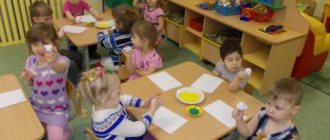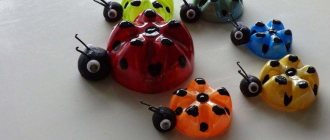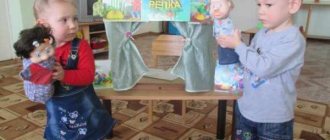Abstract of the GCD on design for children of the second junior group “Different paths for cars”
Otvodnikova G.N.
Abstract of the GCD on design for children of the second junior group “Different paths for cars”
Types of children's activities:
gaming, communicative, cognitive-research, productive.
Goals:
teach children to build paths by placing parts, develop gaming skills, imagination, motor skills, auditory perception, speech, memory, thinking, activate vocabulary on the topic..
Planned results:
takes an active part in productive activities (designing paths for cars); takes part in games (“Wonderful bag”, “Traffic light”); masters age-appropriate simple movements; answers the teacher's questions when discussing and playing with the building, constructs elementary buildings according to the model, and shows a desire to build independently.
Materials and equipment:
construction kits, toy cars, a bag, toy steering wheels (according to the number of children), a “magic” wand, red and green circles.
Preliminary work:
reading the poem by V. Berestov “About the car.”
Progress of the lesson
1. Organizational moment.
Mishutka drives into the group in a toy car and tells the children that his car has had trouble. The car is sick, and he doesn’t know how to help it. Mishutka asks the children for help. Children suggest ways to treat the machine.
2. Main part. Construction.
Educator. Guys, let's build a road for Mishutka's car so that she has somewhere to ride and she never gets sick again. What do we need for this? (Bricks). How many bricks do we need? (A lot of).
The teacher invites the children to bring large bricks from a building set and put them in a separate box. When the children bring the bricks, the teacher gives everyone the same number of bricks and shows construction techniques: he places the bricks on the carpet, pressing them tightly together with a short edge, then invites each child to lay out part of the road in turn.
3. Examination, discussion and play with the building.
Educator. So our road is ready. Look how long it is. What did we build it from? (Made from bricks).
What color are they?
(Children's answers).
How many bricks did we take to build the road?
(A lot of).
Mishutka rides in a car along the road, thanks the children for their help. Now he knows what to do so that his machine does not hurt.
4.
Physical education)
Teacher. Look what I have in my hands. This wand is magical. I will touch each of you and you will turn into drivers. And I will turn into a traffic light. What traffic light signal can you go to? ( On green signal
).
What should you do when the signal is red? ( Stand
).
One, two, three, turn into a driver! (The teacher touches each child with a “magic” wand. The game “Traffic Light” is played).
Educator. One, two, three, four, five, we're done playing! ( Children sit on chairs
).
5.
Game "Magic bag".
Educator. Guys, where did our cars go? Let's look for them together. ( Children are looking for cars in a group. The teacher draws the children’s attention to the bag
) Look what this bag is, it is very heavy.
(He takes the bag and pretends it’s heavy.)
Let’s each put his hand in the bag and find out what’s in there.
Children take turns pulling out small toy cars.
- Who hid in the bag? (Cars).
What size cars are they?
(Little ones).
6. Reflection.
The teacher invites the children to build paths for small cars using small bricks. Children build paths and play with buildings.
Used Books
1. L.V. Kutsakova. Artistic creativity and design. Scenarios for classes with children 3–4 years old. – M.: MOSAIC-SYNTHESIS, 2016.
2. O.P. Vlasenko, T. V. Kovrigina. Complex classes according to the program “From birth to school” edited by N. E. Veraks, T. V. Kovrigina. 2014
Presentation on the topic: Construction in the second junior group Author: Meltzer N. - presentation
Presentation on the topic: Construction in the second junior group Author: Meltzer N.
The importance of design in the harmonious development of children: Design is a practical activity aimed at obtaining a specific, pre-conceived product. Children's design (creating various buildings from building materials, making crafts and toys from paper, cardboard, wood, etc.) is closely related to play and is an activity that meets the interests of children.
By constructing, the child learns not only to distinguish the external qualities of an object or sample (shape, size, structure, etc.); He develops cognitive and practical actions. In design, the child, in addition to visual perception of the quality of the object, actually, practically disassembles the sample into parts, and then assembles them into a model (this is how he carries out both analysis and synthesis in action).
In the process of constructive activity, children form generalized ideas. In the process of teaching children how to construct different designs of homogeneous buildings or toys, conditions are created for the development of creative skills in design. In the process of design activities, children learn the correct geometric names of the parts of a building set. Construction helps improve children’s speech. Construction in the classroom and in games are a means not only of mental education, but also of the formation of moral qualities of the individual
Types of design in a preschool institution: Design from building materials Design from paper and additional materials Design from natural materials
Construction from building materials Even in early age groups, children are introduced to play building materials: first with cubes and bricks, then gradually the material is diversified. From the details of this material, children display familiar objects in their buildings.
Designing from paper and additional materials This type of designing is taught to children in middle, high school and preparatory school groups. It is not easy to build a three-dimensional toy from flat material (paper and thin cardboard), since both paper and cardboard are prepared in the form of squares, rectangles, circles, and triangles.
Construction from natural material Starting from the middle group, chestnut fruits are used for construction; pine cones, spruce, alder shells, bark, branches, twigs of a dead tree, straw, acorns, maple seeds, etc.
Construction in the second junior group. Construction from building materials Children of the second younger group are already developing the ability to correctly name the parts of a building set (cube, brick, plate); They learn to distinguish one shape from another and correctly name the color of parts. They learn some simple construction techniques: connecting bricks, placing them on a plane in one or two rows, vertically in a row or closing a space. Children should learn to build simple objects as shown by the teacher: a tower, a gate, furniture, a house. Children of the second younger group are already developing the ability to correctly name the parts of a construction set (cube, brick, plate); They learn to distinguish one shape from another and correctly name the color of parts. They learn some simple construction techniques: connecting bricks, placing them on a plane in one or two rows, vertically in a row or closing a space. Children should learn to build simple objects as shown by the teacher: a tower, a gate, furniture, a house.
Gate House Tower
It is necessary to consolidate the ability to distinguish parts of a building by size, shape; the ability to determine what parts a building is made of and in what sequence the work should be done. It is necessary to create in children a sustainable interest in playing with buildings, while also using other toys. Children should develop the ability to construct buildings according to their own plans, using the acquired constructive skills.
Methods of teaching plot design to children 2–3 years old.
Home construction.
We have been working with our children for almost a year now and we are very happy that parents are noticing success in their children, in particular, in design. I invited parents to watch their children at home during the construction process. This is what happened.
We work closely with parents, offer them consultations on the topic, show them the results of our work in the evening or in photos, and exchange experiences.
List of sources used
1.Novoselova S.L. Exercises with building materials. // In the book: Education and training of young children. A book for kindergarten teachers. / ed. L.N. Pavlova. – M., Education, 1986. – P.147-152
2.Novoselova S.L. Development of thinking at an early age. - M.: Pedagogy, 1978. - 160 p.
3. Paramonova L.A. Theory and methodology for the formation of creative design in preschool age. – M.: Publishing House Academy, 2002. – 192 p.
Internet resources:
1. Design at an early age https://www.maam.ru/detskijsad/konstruirovanie-v-ranem-vozraste.html
2. E. Yanushko Construction with young children 1-3 years old: the best and most effective methods.
https://elenayanushko.ru/php/content.php?id=560
3. O. Litvinova: Construction with children of early preschool age. Summaries of joint activities. Federal State Educational Standard https://www.labirint.ru/books/476734/
CONSTRUCTION
WITH EARLY CHILDREN
Of the year
The best and most effective techniques
Developed by a famous specialist in the field of early childhood development, Elena Yanushko!
Using and improving techniques for 22 years!
Dear adults!
Currently, early development ideas are becoming increasingly popular. Progressive specialists and parents of children 1-3 years old agree that the sooner you start comprehensive classes with your child, the more successfully and quickly he develops. We can say that by creating a developmental environment for the baby, we give him a chance to realize the potential given to him from birth!
One of the important areas of a child’s development is the development of his thinking. Such an important activity as construction not only helps to develop a child’s practical thinking, but is also a stimulus for the development of children’s creativity.
But if designing with preschoolers is a familiar and understandable topic for many, which is supported by an abundance of various materials - flat and three-dimensional construction sets with different assembly principles, then how to design with the little ones is not very clear for most parents and some specialists... We bring to your attention modern construction techniques with young children that allow you to organize activities with kids in the most effective way! The main task of an adult is to choose suitable material for classes and interest the child.
We wish you success in your development!
AUTHOR
Elena Albinovna Yanushko is a famous teacher, psychologist, speech therapist, author of methods for the development and training of children and about 280 practical books on the development of speech and thinking, learning to read, sensory development, the formation of mathematical concepts, learning to draw, sculpt, appliqué, and design. The author's teaching experience is 22 years. More detailed information about the author can be found on his personal website: www.elenayanushko.ru
PROJECT HISTORY
Work on creating interesting and useful design tasks for the little ones began several years ago and is currently in an active stage: materials for the methodological guide “Construction with Young Children” are being analyzed and summarized.
In 2013, the Eksmo publishing house (as part of the author’s project “New Child”) published the first books on designing for children in their third year of life. Later, materials for design tasks were also published in the form of a collection.
CONTENT OF THE PROJECT “CONSTRUCTION WITH EARLY CHILDREN”
(as part of the author’s project “New Child” by Eksmo Publishing House)
THEORY
PRACTICE
Book 1. Assemble the halves 2+
On the pages of this book, your child will learn to connect halves of an image, resulting in a whole object. The baby will definitely like the interesting stories that accompany the tasks: the baby will let a cute ladybug go for a walk, give a bee a large daisy, give the kids a beautiful ball to play with, fix a broken pyramid, treat a hare with a carrot, entertain the baby with a rattle, put a warm hat on the baby’s head, let her swim the fish. All tasks are completed directly on the pages of the book, containing bright illustrations. Inside the book you will find a tab with elements to cut out. If you first glue them onto cardboard and then cut them out, you will get stronger figures that will last longer. And so that the cut pictures don’t get lost, it’s convenient to store them in an envelope.
Book 2. Houses made of laces 2+
This book offers an unusual type of design - laying out images from multi-colored laces. Adults may find this type of task too simple, but try to offer the task to a child and you will see that it presents enough difficulty for the child, which helps him develop useful skills and fine motor skills. On the pages of the book you will find interesting stories that the baby will like: by laying out colored laces on the base picture, the baby will make a lake for a fish, a hole for a mouse, a den for a bear cub, a hollow for a squirrel, grass for a grasshopper, a pen for a pig, a nest for a bird, fence for the dog. All tasks are completed directly on the pages of the book, containing bright illustrations.
Book 3. Wand by Wand 2+
On the pages of this book, the child constructs from counting sticks - material available to everyone for constructing on a plane. By folding counting sticks on the base picture, the child will create simple but interesting images - a path for a man and mountains for a lamb, a fence for a rabbit, a ladder for a monkey, a doghouse for a dog, a mushroom for a hedgehog, a house for a man, a stand for a circus elephant. All tasks are completed directly on the pages of the book, containing bright illustrations, which makes the task understandable and its result visual for the child. To complete the tasks in the book you will need counting sticks.
Book 4. Magic circles 2+
On the pages of this book, your child will learn to create images by folding circles of different colors and sizes. The kid will definitely like the interesting stories that accompany the tasks: the kid will help a cute chicken hatch from an egg, “fashion” a snowman, make a caterpillar and a ladybug, “build” a toy pyramid, treat a girl with a bunch of grapes, give a flower to a bee, and give a doll to a baby. tumbler All tasks are completed directly on the pages of the book, containing bright illustrations. Inside the book you will find a tab with elements for applique. If you first glue sheets of circles onto cardboard and then cut them out, you get more durable construction elements that you can play with for a long time.
Book 5. Building a house 2+
On the pages of this book, the child constructs from geometric shapes. By adding simple recognizable images from geometric shapes of different colors and sizes on the base picture, the child will build a house, make a beach umbrella, make ice cream, plant a tree, make a flag, a balloon and a cart, and build a sandbox for children. All tasks are completed directly on the pages of the book, containing bright illustrations - they help make the task more understandable and visual for the child. Inside the book there is a tab with shapes for cutting.
Book 6. Bows and wrappers 2+
On the pages of this book, the child constructs from geometric shapes. By adding simple recognizable images from geometric shapes of different colors on the base picture, the child will make bows for girls, hats for babies, fish in the sea, houses for gnomes, candy in candy wrappers, soldiers and dolls, and a large flower. All tasks are completed directly on the pages of the book, containing bright illustrations. Inside the book there is a tab with shapes for cutting.
Book 7. Designing with your baby. Sticks and figures 2+
This collection is dedicated to the most important type of productive activity of a child - construction. The tasks in the book are selected taking into account the age characteristics of the child, who is just beginning to get acquainted with a variety of materials, learns various methods of construction, and thereby receives a powerful impetus for the development of thinking. The book has 3 special tabs with geometric shapes for classes.
FOR WHOM IS THE PROJECT CREATED?
A set of materials for designing with young children is useful for everyone who has small children - both the child’s loved ones and specialists! Presenting design materials in the form of a system is our unique proposal, which helps to get a better understanding of the features of design classes with kids and presents a range of modern planar design techniques that are convenient to present on the pages of books. Using this system, you will not have to waste time searching for useful books and interesting tasks - all this has already been collected, developed and systematized in our books. The materials presented are sufficient for many interesting, exciting and useful activities!
PREPARATION FOR CLASSES
Minimal preparation for classes is required. The main thing is to purchase books and some necessary materials for designing on the pages of books (counting sticks, strings, etc.) - you can take them and practice. Practical books for design classes with children are specially designed for untrained users. Each lesson book comes with brief instructions, which are enough to get you started with the book, but you need to read it carefully. The theoretical basis of the presented methods, together with a description of practical exercises, is currently at the preparation stage.
HOW TO DESIGN WITH A BABY? (author's recommendations)
Who can the child study with?
· With parents – mom, dad
· With loved ones - grandfather, grandmother, aunt, brother or sister...
· With a tutor
The main thing is that classes are held with pleasure and a positive mood for both the child and the adult!
Exercises at home
Classes can be held at home, as they do not require special training or special equipment. All you need for classes is our books and some simple materials.
Classes at the institution
The methodology can be successfully used in a preschool educational institution (kindergarten, development center) - it is very convenient to use, offers a wide range of tasks for use by specialists, and contains methodological recommendations and practical materials.
Time of one lesson
The time of one lesson can vary from 5-10 to 20-30 minutes depending on the age and level of training, as well as the stamina of the child, his condition and mood at the moment. It is better to study when the baby is full, happy and not busy with something important to him. Be flexible - end the lesson at the first sign of your baby's fatigue. Remember: it’s better to “under-exercise” a little than to over-exercise.
Frequency of classes
The recommended frequency of design classes is 2 times a week. However, if your child really likes to design, you can do it every day! No harm, only benefit, because design is a very useful activity.
Procedure for using construction materials
The materials can be used very flexibly: for example, perform tasks in the book in order, also use books one after another, or you can choose the book during the lesson and use the technique that is most interesting to the child at the moment, or the content of the lesson coincides with the topic being studied. Each book can be used for a long period of time, gradually complicating the design tasks, adding your own details, offering your child new art materials and drawing methods.
REVIEWS
I like the activity
I would recommend using this notebook when your child easily copes with the tasks from the “Building a House” notebook from the same series. There you need to assemble from 2-3 figures, but here everything is much more complicated. My daughter completed that notebook quickly, she really likes this activity, so we’ll make it more difficult. (book “Bows and wrappers” - approx. E.Ya.).
Anyuta's mom
https://www.labirint.ru/reviews/show/743927/
PHOTO GALLERY
Methods of teaching plot design to children 2–3 years old.
Stages of development of children's creative construction: in the second group of early kindergarten, construction is merged with plot-display play, acting both as its element and as a means of helping to play out simple plots. The latter, in turn, is the motive for creating simple structures. That’s why it’s called “plot construction”: children build a crib and put the doll to sleep, build a path for it so that it can go for a walk after sleep, etc. The initiative belongs to the teacher, and the children only follow his requests, instructions like “Move the brick closer "
Stage I – stage of primary development of knowledge and skills (according to samples)
Stage II – the stage of creative application of knowledge and skills in
specially organized adult conditions (according to conditions)
Stage III – the stage of independent creative application of acquired knowledge and skills (as planned)
Plot design goals:
· Development of the ability to plan activities and analyze work performed
· Development of fine motor skills, speech, cognitive and research activity
· Formation of the desire for independent creative search,
initiative
· Development of creative thinking and imagination
· Formation of sensory abilities
· Formation of spatial representations
Plot construction is organized in the process of GCD, in individual work, in the process of organizing free activity. The plot is determined in accordance with thematic planning, age and individual characteristics and interests of children. The plots should be understandable for a 2-3 year old child and should consist of 2-3 sentences.
Materials for plot design. To organize plot construction, we use sets of wooden building material (type Agapova material, containing geometric shapes: cubes, prisms, plates, bricks of different colors), large-sized modules and LEGO-type construction sets.
Toys for plot construction. When acting out plots, you can use a variety of toys, which must be commensurate with the building material (matryoshka dolls, Christmas trees, cars, etc.); For these purposes, you can also use various elements from the role-playing sets “Zoo”, “Pets”, “Firemen and Rescuers”, etc.
OD on “plot construction” is carried out in subgroups (4-5 children each). Design in the process of GCD corresponds to long-term and comprehensive thematic planning. For example, simple plots like “Dolls sleep and walk”, “Dolls eat”, “Cars drive along the street and enter the garage”, “Birds flew in and sat on the turret, on the gate”, “The little nesting doll lives in a small house, and the big one - in a big way”, etc.
The process of making a house for animals (within the theme “Wild Animals”) in stages: plot (problem), demonstration of the method of construction by the teacher, independent activity of children followed by play, types, animals will go to visit each other. The initiative always belongs to the teacher. It is very important that all children participate in acting out and constructing all plots. At the end of each lesson, children should be encouraged to put the material together in a box. Finding a place in a limited space for each shape of a part, taking into account other shapes, helps develop children's sensory abilities and ability to navigate in space.
OD "Teremok". I would like to dwell on this fairy tale in more detail, because it easily integrates different types of activities. We have modules from which we build something in free activity, but very rarely use them in GCD. We did preliminary work: with the help of parents, we made masks of the heroes, read a fairy tale, showed the fairy tale using different types of theater, and then invited the children to play the fairy tale. I built a small house in advance, offered to choose a role, and we began to “play.” Construction was at the last stage of our presentation; we built a new house for the animals. The kids really enjoyed it, especially the role of the bear who breaks the tower and the subsequent joint construction of always a new tower
Design in individual work. The basis for choosing a theme, material and plot is always a child. If I see that he is having difficulty during the game, then I try to gradually develop his imagination in individual work. Or maybe, on the contrary, during the GCD process the child did not cope with the task, then in individual work we go through all the stages again. For example, “House with a window for a hare”, “Crib for a matryoshka doll”, “Path to the red and green house”.
Design in independent activity . Let's start with the fact that there is no independent activity in its pure form at this age. In all types of activities, the teacher plays a large role; the work of the teacher is present everywhere due to the age of the children. I offer children different types of construction sets to choose from, I offer plots, I set a goal, but during the game the plot can change, so it is important to support the children at this moment. How to support? Admiration, approval, praise. At this stage of work, it is important to say that in general, children work (play) with the construction set not collectively, but rather individually. After all, if you look closely at the play of two children sitting next to each other, you can see that they each have their own buildings, or one looks at the work of the other without taking any part.
We built boats, cars, and houses. Each time we came up with different plots, took fragments from plot-display games, built cities, etc. In other words, we did everything so that the children developed creative thinking and imagination in the process of plot construction.
Thus, the plot design method is an effective assistant in teaching specific constructive techniques - it eliminates the possibility of thoughtless, mechanical imitation, and prevents the manifestation of such undesirable actions as a disorderly accumulation of details. This is important because it is at an early age that visual and effective thinking and imagination are intensively formed, which is expressed, first of all, in the practical solution of subject problems.
Home construction.
We have been working with our children for almost a year now and we are very happy that parents are noticing success in their children, in particular, in design. I invited parents to watch their children at home during the construction process. This is what happened.
We work closely with parents, offer them consultations on the topic, show them the results of our work in the evening or in photos, and exchange experiences.
List of sources used
1.Novoselova S.L. Exercises with building materials. // In the book: Education and training of young children. A book for kindergarten teachers. / ed. L.N. Pavlova. – M., Education, 1986. – P.147-152
2.Novoselova S.L. Development of thinking at an early age. - M.: Pedagogy, 1978. - 160 p.
3. Paramonova L.A. Theory and methodology for the formation of creative design in preschool age. – M.: Publishing House Academy, 2002. – 192 p.
Internet resources:
1. Design at an early age https://www.maam.ru/detskijsad/konstruirovanie-v-ranem-vozraste.html
2. E. Yanushko Construction with young children 1-3 years old: the best and most effective methods.
https://elenayanushko.ru/php/content.php?id=560
3. O. Litvinova: Construction with children of early preschool age. Summaries of joint activities. Federal State Educational Standard https://www.labirint.ru/books/476734/
CONSTRUCTION
WITH EARLY CHILDREN
Of the year





